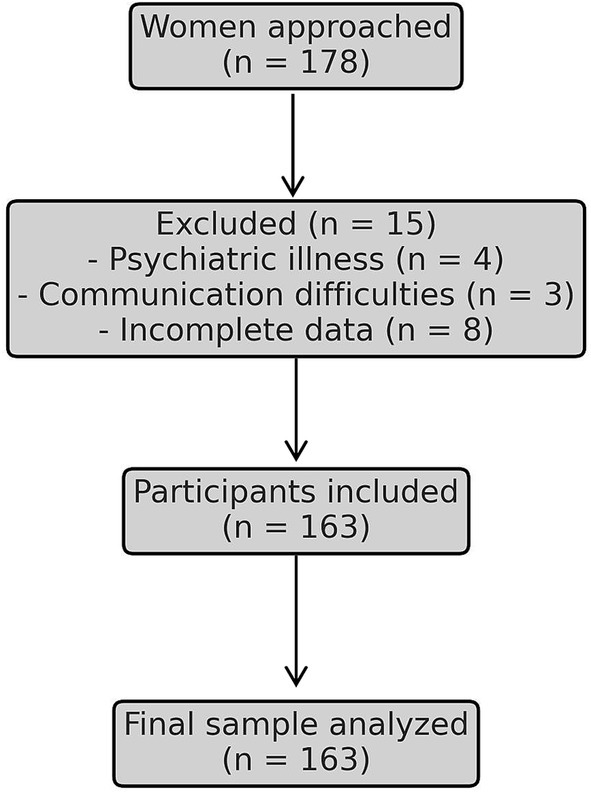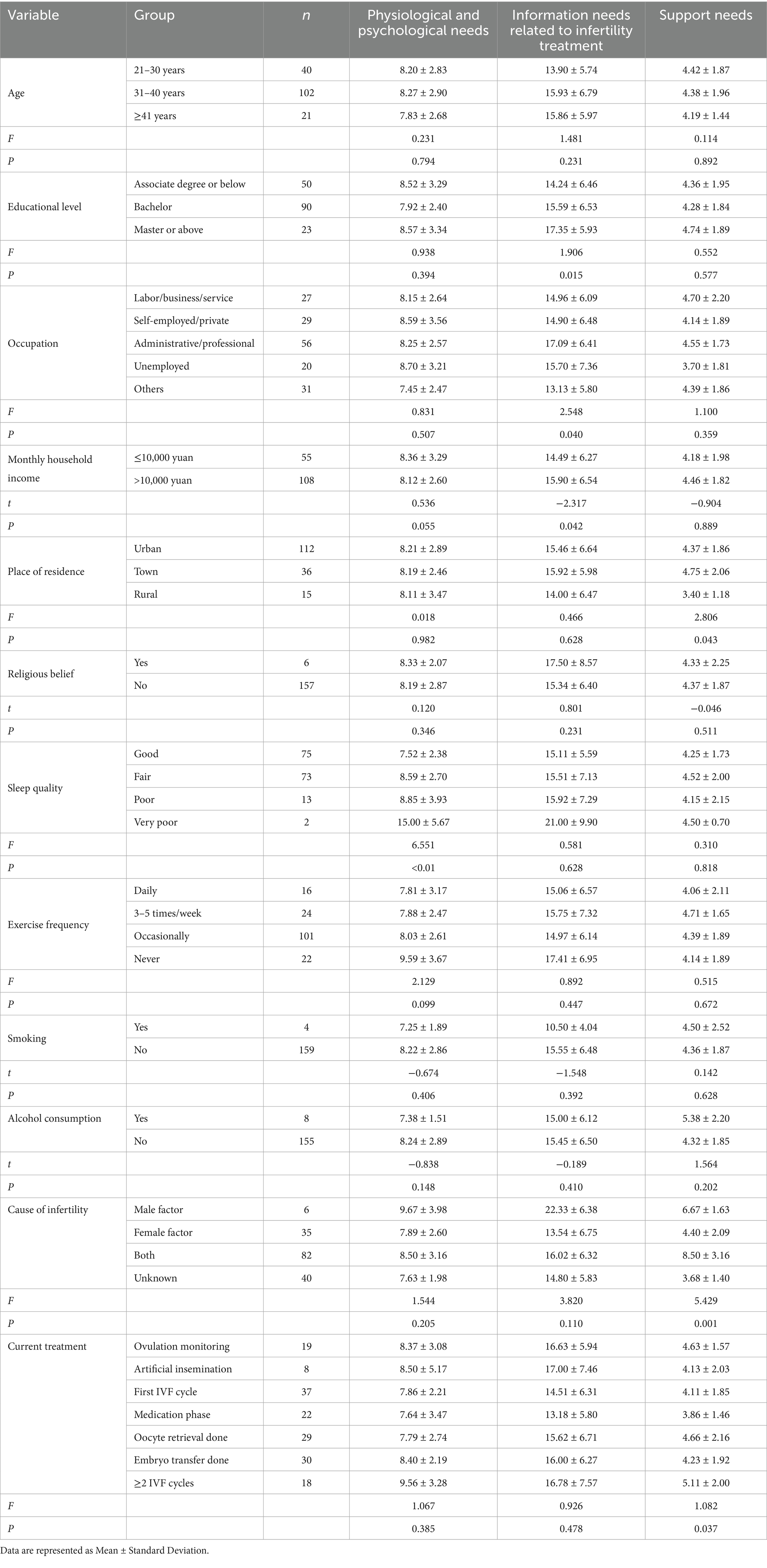- 1Reproductive Center, Second Affiliated Hospital of Naval Medical University, Shanghai, China
- 2Department of Obstetrics and Gynecology, Second Affiliated Hospital of Naval Medical University, Shanghai, China
- 3Department of Nursing, Fengcheng Hospital, Shanghai, China
Objective: To investigate the status and influencing factors of nursing care needs among women undergoing infertility treatment, and to inform personalized and stage-specific nursing strategies.
Methods: A cross-sectional study was conducted among 163 infertile women receiving outpatient treatment at a tertiary reproductive center in Shanghai between December 2024 and February 2025. General demographic and clinical data were collected using structured questionnaires. The Nursing Needs Assessment Scale for Infertility Patients was used to evaluate three dimensions of nursing demands. Differences in needs scores were compared across treatment stages and sleep quality levels. Pearson correlation and multiple linear regression analyses were performed to identify influencing factors.
Results: Across all participants, the total nursing needs score averaged 37.8 ± 7.9 (range: 22–58). Mean dimension scores were 8.20 ± 2.84 for physiological and psychological needs, 15.42 ± 6.47 for information needs, and 4.37 ± 1.88 for support needs. Strong positive correlations were observed among the three dimensions (r = 0.65–0.76, all p < 0.001). Nursing needs varied significantly across treatment stages: women with ≥2 IVF cycles reported higher total needs (43.54 ± 8.75) than those in ovulation monitoring (35.29 ± 7.12) or first IVF cycle (36.42 ± 7.88; p < 0.001). Support needs differed significantly across treatment phases (p = 0.037). Sleep quality was also a key determinant: patients with very poor sleep had the highest needs (total score 48.12 ± 6.37) compared with those reporting good sleep (34.16 ± 6.89; p < 0.001). Multivariate regression confirmed that poor sleep quality predicted higher physiological and psychological needs (β = 1.087, p = 0.002), higher educational attainment was associated with stronger information needs (β = 1.669, p = 0.045), and advanced treatment stage independently predicted higher support needs (β = 0.082, p = 0.003). The adjusted R2 of the final model was 0.21.
Conclusion: Infertile women present with moderate to high levels of multidimensional nursing needs, which are significantly influenced by sleep quality, education level, and treatment stage. These findings highlight the importance of dynamic, individualized, and stage-specific nursing interventions to improve patient experience and treatment outcomes in assisted reproduction.
Introduction
Infertility, defined as the inability to achieve a clinical pregnancy after 12 months or more of regular unprotected sexual intercourse, currently affects approximately 10–15% of couples of reproductive age worldwide (1, 2). With demographic transitions, environmental pollution, and shifting reproductive choices, the global incidence of infertility is steadily increasing, placing substantial physical, emotional, and economic burdens on affected individuals and healthcare systems (3). In China, infertility has become a major public health concern, with an increasing number of couples seeking medical assistance to fulfill their reproductive desires (4, 5).
Assisted reproductive technologies (ART), such as ovulation induction, intrauterine insemination, and in vitro fertilization (IVF), have emerged as the cornerstone of clinical management for infertility. Despite technological advances and expanding access, ART remains a complex, prolonged, and psychologically taxing process. Women undergoing infertility treatment are often subjected to repeated hormonal stimulation, invasive procedures, high financial costs, and substantial emotional uncertainty regarding treatment outcomes. These factors collectively contribute to a heightened risk of psychological disorders, including anxiety, depression, and sleep disturbances, which may peak during specific treatment phases (6, 7). Importantly, accumulating evidence suggests that these psychosocial burdens may not only affect patients’ mental health but also reduce treatment compliance, undermine therapeutic efficacy, and adversely impact reproductive outcomes (8).
Within this context, professional nursing support plays an indispensable role. Beyond basic physiological care, infertility patients have expressed growing needs for emotional support, reliable health information, decision-making assistance, and social inclusion (9). Timely identification and fulfillment of these multidimensional nursing needs are essential to alleviating patients’ psychological distress, improving their engagement with treatment, and enhancing satisfaction and outcomes. However, existing studies on infertility care have predominantly focused on medical or psychological aspects, while systematic evaluations of nursing needs remain scarce in the Chinese context. Moreover, few studies have explored how nursing needs evolve across different treatment stages, or how modifiable factors such as sleep quality contribute to these needs (10, 11).
To address these knowledge gaps, this study aims to comprehensively assess the nursing care needs of infertile women and identify key influencing factors. Guided by patient-centered care principles and behavioral health frameworks, we conceptualize nursing needs as dynamic responses shaped by both psychosocial stressors (e.g., sleep disturbance, emotional distress) and treatment-related challenges (e.g., repeated IVF cycles, high financial burden). This theoretical lens allows us to examine not only the prevalence of nursing needs but also the mechanisms through which individual and contextual factors shape them in assisted reproduction. Particular attention is given to treatment stage and sleep quality, which may serve as practical indicators for personalized and dynamic nursing intervention. The findings may contribute to the development of more effective, stage-specific, and patient-centered care models in reproductive medicine.
Materials and methods
Study design and participants
This cross-sectional study was conducted at the outpatient infertility clinic of a tertiary reproductive center in Shanghai between December 2024 and February 2025. A total of 163 female patients undergoing infertility evaluation or treatment were recruited using convenience sampling. Recruitment procedures involved consecutive screening of women attending the outpatient infertility clinic during the study period. Of 178 women initially approached, 15 were excluded due to not meeting inclusion criteria (psychiatric illness = 4, communication difficulties = 3, incomplete survey data = 8), resulting in 163 participants included in the final analysis. The participation rate was therefore 91.6%. Inclusion criteria were: (1) diagnosed with primary or secondary infertility according to WHO criteria; (2) currently receiving or preparing for assisted reproductive technology (ART) treatment; (3) aged 20–45 years; and (4) able to provide informed consent and complete the survey independently. Exclusion criteria included major psychiatric illness, communication disorders, or incomplete data.
The required sample size was estimated based on the number of independent variables planned for regression analysis. Assuming 15 predictor variables, a minimum of 8 cases per variable was set, resulting in 120 participants. Allowing for a potential 15% exclusion rate, the recruitment target was set at 163. Post-hoc power analysis indicated that with 163 participants and an effect size of f2 = 0.15 (medium), the regression model achieved >80% power at α = 0.05, supporting adequacy of the sample size.
General information questionnaire
The general questionnaire was developed by the research team based on a review of the literature and expert group discussions. It was designed to collect sociodemographic and lifestyle data, including age, educational level, occupation, monthly household income, place of residence, religious belief, self-reported sleep quality, exercise frequency, smoking and alcohol use, cause of infertility, and current treatment type. Sleep quality was assessed using a single-item Likert measure (good, fair, poor, very poor), which has been widely used in clinical and epidemiological research for its brevity and feasibility when respondent burden is a concern. To address sparse categories, sensitivity analyses were performed by collapsing levels (good/fair vs. poor/very poor), and the associations remained robust. Additionally, regression models were tested with ordinal coding to account for trends across categories. Although not as comprehensive as validated tools such as the Pittsburgh Sleep Quality Index (PSQI), this single-item measure has demonstrated good convergent validity with multi-item scales in prior studies. To address potential limitations, sensitivity analyses were conducted by collapsing categories (good/fair vs. poor/very poor), and the observed associations with nursing needs remained consistent.
Chinese version of the infertility nursing needs assessment scale
The original “Nursing Needs Assessment Scale for Infertile Patients” was developed by Park et al. (8) in South Korea. The Chinese version used in this study was translated and culturally adapted by Li et al. (12). In addition to internal consistency, Li et al. (12) reported satisfactory structural validity through confirmatory factor analysis (CFA), supporting the three-factor model of the scale, as well as acceptable test–retest reliability over a two-week interval (ICC = 0.82). Cross-cultural adaptation followed COSMIN guidelines, including forward–back translation and expert panel review, ensuring conceptual equivalence across contexts. The scale comprises 15 items grouped into three dimensions: (i) physiological and psychological needs, (ii) information needs related to infertility treatment, and (iii) support needs. Each item is rated on a 5-point Likert scale ranging from 1 (“not needed”) to 5 (“very much needed”). Total scores range from 15 to 60, with higher scores indicating greater overall nursing needs. In the present study, the Cronbach’s α coefficient for the total scale was 0.915, and for each subscale ranged from 0.905 to 0.913, indicating excellent internal consistency.
Survey administration and data quality control
Participants were recruited from a specialized infertility outpatient clinic. After obtaining informed consent, general information was collected through face-to-face interviews by trained research personnel. The nursing needs questionnaire was administered electronically via a secure WeChat-based survey platform. Participants were provided with instructions and given 20–30 min to complete the form. To ensure data completeness and validity, the electronic survey was programmed with mandatory fields, dropdown menus, and time constraints. After submission, all responses were screened for logical consistency and completeness. Questionnaires with repetitive patterns or inconsistent responses were excluded. A total of 163 electronic questionnaires were distributed, collected, and deemed valid. Although this yielded a 100% effective response rate among included participants, the denominator reflects only those eligible and willing to participate (163/178). Clarification is thus provided to avoid overestimation of response rates.
Variable definitions and grouping
Participants were grouped according to treatment stage: (1) ovulation monitoring, (2) first-time IVF, and (3) second or more IVF cycles. Sleep quality was self-assessed and categorized as: good, fair, poor, or very poor. These groupings were used to explore variability in nursing needs across clinically relevant subpopulations.
Statistical analysis
All statistical analyses were conducted using SPSS version 26.0 and Python (for advanced plotting). Continuous variables were tested for normality using the Shapiro–Wilk test and presented as mean ± standard deviation. Categorical variables were summarized as frequencies and percentages. Group differences in nursing needs scores across treatment stages and sleep quality categories were evaluated using one-way ANOVA with post hoc pairwise comparisons (LSD or Games–Howell as appropriate). Pearson correlation analysis was performed to examine relationships among the three dimensions of nursing needs. Multiple linear regression analysis was used to identify independent predictors of total nursing needs score, with covariates including age, education level, income, treatment stage, and sleep quality. Although variables with p < 0.1 in univariate analysis were initially considered, the final regression model was prespecified based on theoretical and clinical relevance (sleep quality, educational level, and treatment stage) to reduce risks of bias and overfitting. This approach aligns with recommendations for constructing parsimonious, theory-driven models. Regression results are reported with unstandardized coefficients (β), standard errors, standardized coefficients, 95% confidence intervals, and adjusted R2 values. Diagnostic checks (multicollinearity, residual normality, homoscedasticity) confirmed model validity.
Results
General characteristics of participants
A total of 163 infertile women were included in the analysis. The participant flow is depicted in Figure 1, illustrating the number approached, excluded, and retained in accordance with STROBE guidelines. The majority were aged 31–40 years (62.5%). Unexplained infertility accounted for 23.9% of cases, while 10.7% had undergone two or more IVF cycles. Detailed demographic and clinical characteristics are presented in Table 1.
Total nursing needs score
Across all participants, the total nursing needs score averaged 37.8 ± 7.9, with a median of 36 (IQR: 32–43) and a range of 22–58. By treatment stage, women with ≥2 IVF cycles reported the highest needs (43.54 ± 8.75), compared to those in ovulation monitoring (35.29 ± 7.12) and first IVF cycle (36.42 ± 7.88; all p < 0.001). By sleep quality, patients reporting very poor sleep scored 48.12 ± 6.37, versus 34.16 ± 6.89 among those with good sleep (p < 0.001).
Univariate analysis of nursing needs dimensions
The mean scores of the three nursing need dimensions were 8.20 ± 2.84 for physiological and psychological needs, 15.42 ± 6.47 for information needs, and 4.37 ± 1.88 for support needs. Univariate analysis of demographic and clinical characteristics is summarized in Table 1. Age was not significantly associated with any dimension of nursing needs (all p > 0.05). Educational level showed a significant effect on information needs (p = 0.015), with participants holding a master’s degree or above reporting the highest scores. Occupation was also associated with information needs (p = 0.040), as administrative/professional participants scored higher than those in other categories. Monthly household income was positively related to information needs, with women reporting >10,000 yuan per month showing higher scores than those with lower income (p = 0.042). Place of residence was significantly associated with support needs, with urban and town residents reporting higher scores than rural residents (p = 0.043). Religious belief, smoking, and alcohol consumption were not significantly related to any nursing need dimension (all p > 0.05). Sleep quality significantly influenced physiological and psychological needs, with poorer sleep associated with higher scores (p < 0.01). Exercise frequency was not significantly associated with nursing needs, although a trend toward higher physiological and psychological needs was observed in women who never exercised (p = 0.099). Cause of infertility was significantly associated with support needs (p = 0.001), with the highest scores reported among women with male factor infertility. Information needs showed a borderline association with infertility cause (p = 0.110), whereas no significant difference was observed for physiological and psychological needs. Current treatment stage was significantly associated with support needs (p = 0.037), with the highest scores observed in women undergoing two or more IVF cycles. No significant associations were found between treatment stage and the other two need dimensions.
Multivariate regression analysis of influencing factors
Multivariate linear regression identified sleep quality as an independent predictor of physiological and psychological needs (β = 1.087, 95% CI [0.40–1.77], p = 0.002). Educational level significantly influenced information needs (β = 1.669, 95% CI [0.02–3.32], p = 0.045). Current treatment stage was a key determinant of support needs (β = 0.082, 95% CI [0.03–0.39], p = 0.003). The adjusted R2 of the final model was 0.21, indicating modest explanatory power. Diagnostic checks confirmed the absence of multicollinearity, normally distributed residuals, and homoscedasticity, supporting the robustness of the regression models (Table 2).

Table 2. Multiple linear regression analysis of influencing factors among infertile women (n = 163).
Correlations among nursing need dimensions
Pearson correlation analysis revealed strong positive associations among the three dimensions of nursing needs. Specifically, physiological and psychological needs correlated with information needs (r = 0.72), and with support needs (r = 0.65). Information needs were also significantly correlated with support needs (r = 0.76). All correlations were statistically significant (p < 0.001), indicating a high degree of consistency across care domains (Figure 2).
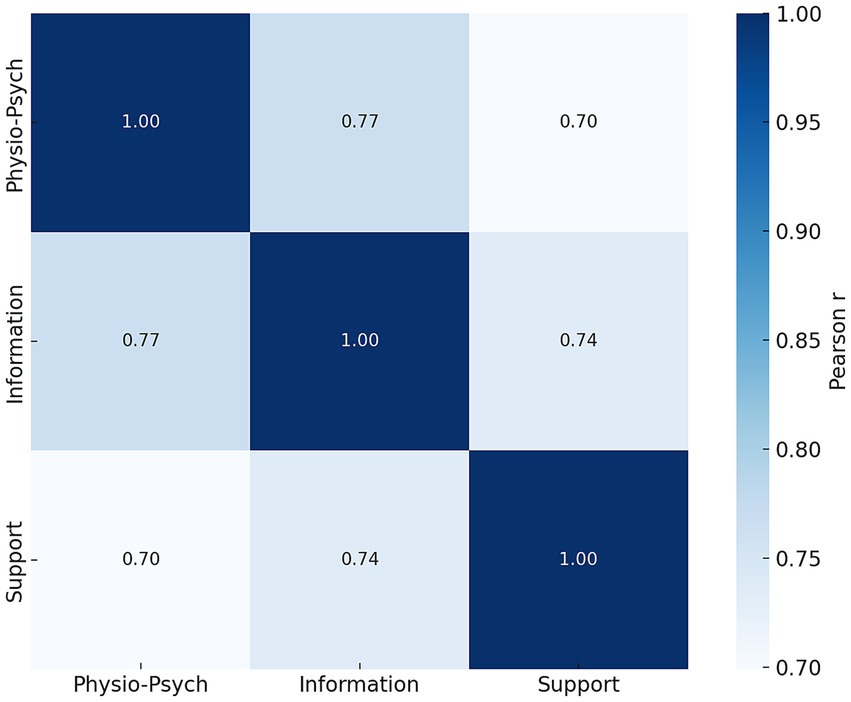
Figure 2. Pearson correlation heatmap among three dimensions of nursing needs. The heatmap displays correlation coefficients (r values) between physiological and psychological needs, information needs, and support needs. Color intensity reflects the strength of the correlations, with darker blue indicating stronger positive associations. All correlations were statistically significant (p < 0.001), suggesting substantial co-occurrence among the three domains of need.
Differences in nursing needs across treatment stages
As illustrated in Figure 3, the mean scores of the three nursing need dimensions varied across treatment stages. Overall nursing needs tended to increase as treatment progressed, reaching a peak in women who had undergone two or more IVF cycles, reflecting the cumulative physical and psychological burden of repeated procedures. Statistical testing showed that only support needs differed significantly across treatment stages (p = 0.037), with the highest scores observed in women with multiple IVF cycles. In contrast, no significant differences were found for physiological and psychological needs (p = 0.385) or information needs (p = 0.478). These results highlight that while the overall trend suggests higher demands in advanced treatment stages, only the support dimension showed statistically significant variation, underscoring the importance of tailored psychosocial and practical support in later treatment phases.
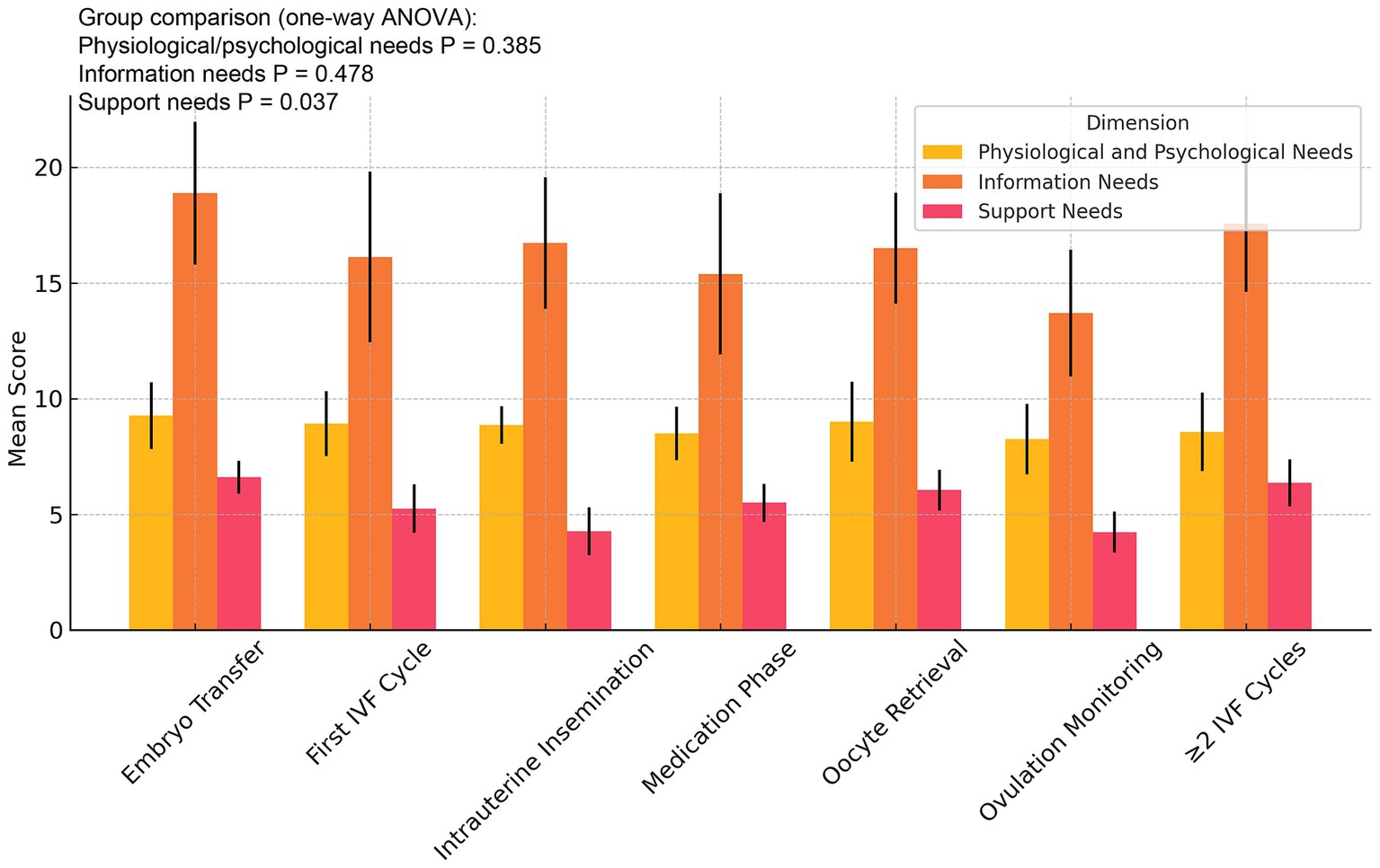
Figure 3. Nursing needs scores across treatment stages in infertile patients. Average scores for physiological and psychological needs, information needs, and support needs are presented across seven treatment stages. Nursing needs increased with treatment progression and peaked among patients undergoing multiple IVF cycles, highlighting the importance of stage-specific nursing support.
Impact of sleep quality on nursing needs
As shown in Figure 4, poorer self-reported sleep quality was consistently associated with higher nursing needs across all three dimensions. Patients with “very poor” sleep had significantly elevated scores for physiological and psychological needs (mean = 14.54) compared to those with “good” sleep (mean = 7.38). Similar trends were observed for information and support needs. These findings suggest that poor sleep exacerbates both physical discomfort and emotional vulnerability, increasing reliance on nursing care. Sleep quality should therefore be integrated into clinical assessments, with targeted interventions aimed at improving both rest and overall well-being.
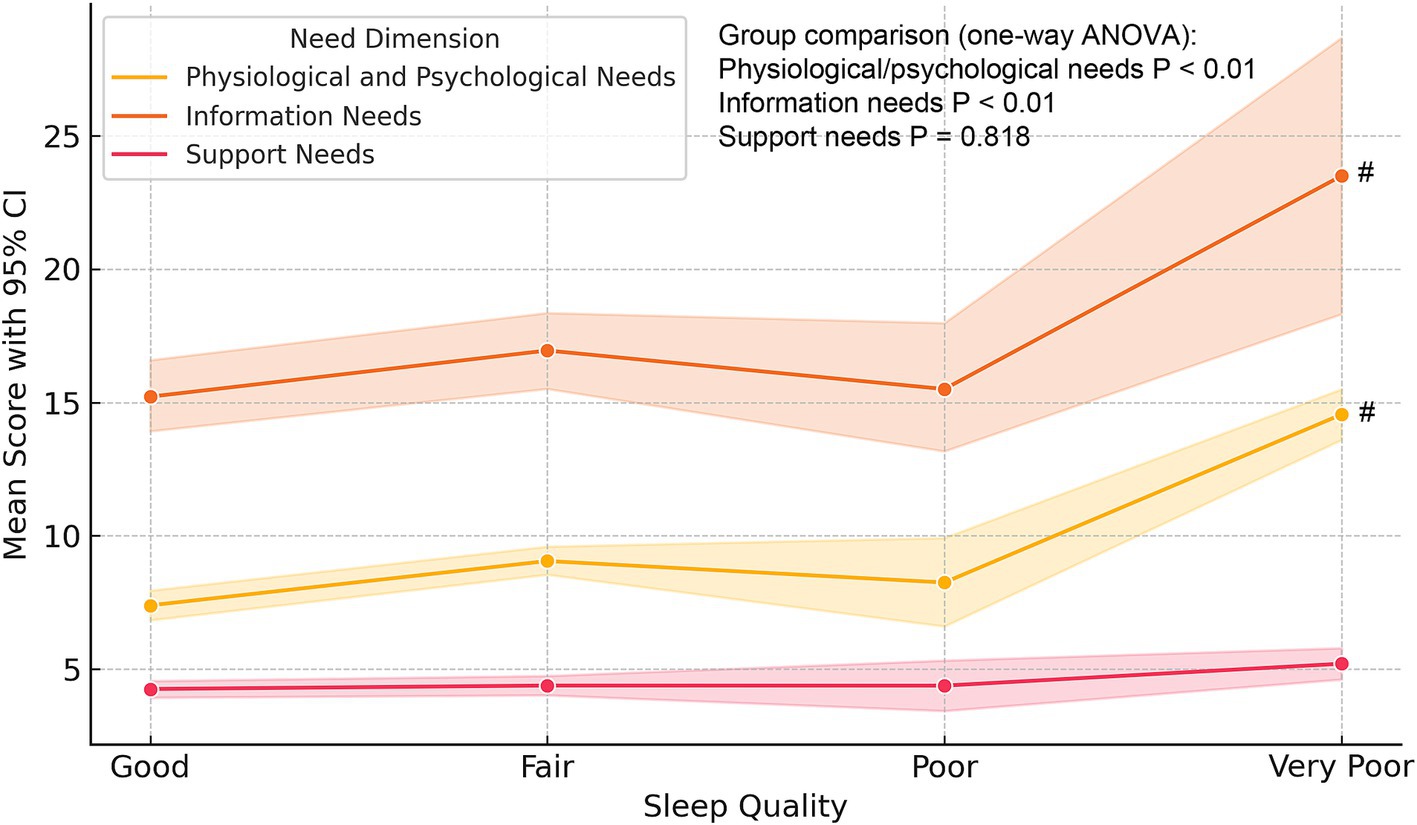
Figure 4. Trends in nursing needs across sleep quality categories in infertile patients. Line plots illustrate the mean scores and 95% confidence intervals for three nursing need dimensions—physiological and psychological needs, information needs, and support needs—across four levels of self-reported sleep quality. A consistent upward trend is observed, with markedly higher scores among patients reporting very poor sleep, indicating that diminished sleep quality is associated with elevated and multidimensional nursing care demands. #: compared with the Good group, p < 0.05.
Discussion
Infertile women exhibit high levels of nursing needs
This study highlights the substantial nursing needs among infertile women undergoing assisted reproductive technology (ART), advancing existing literature in two key ways. First, unlike most prior studies that separately addressed psychological burden or informational demand, we employed a multidimensional patient-centered care framework to capture physiological, informational, and support needs in a single model. Second, we uniquely integrated treatment stage and sleep quality as predictors, offering novel insight into how modifiable psychosocial factors interact with treatment progression to shape patient experiences. Given the cross-sectional design, our findings indicate associations rather than causal predictions; for example, poor sleep quality was associated with greater nursing needs, but longitudinal studies are required to confirm temporal direction. The average scores for physiological and psychological needs (8.20 ± 2.84), treatment-related information needs (15.42 ± 6.47), and support needs (4.37 ± 1.88) were all at moderate-to-high levels, consistent with previous studies by Naab et al. (13). These findings suggest that despite growing familiarity with ART, patients continue to experience strong demands for tailored nursing care and professional guidance. Similar findings have been reported in other Asian countries. For example, a Korean study by Park et al. (8) demonstrated that infertile women exhibited comparable multidimensional nursing needs, particularly in information-seeking and emotional support. In Japan, research on infertility-related stigma also highlighted the persistent psychological distress and demand for professional guidance among women undergoing ART (6). These regional similarities suggest that infertile women across East Asia may share common care needs shaped by cultural expectations, family-oriented social norms, and the high emotional investment in childbearing. While Korean and Japanese studies have emphasized stigma, information-seeking, and emotional distress, our findings add originality by quantifying the role of sleep quality—a rarely examined but modifiable factor—in amplifying multidimensional nursing demands. This perspective expands the understanding of patient-centered care in Asian infertility contexts. The rising demand may be attributed to improvements in medical technology, enhanced psychological adaptability, and increased health literacy. While infertility is often associated with anxiety, depression, and negative self-perception (14), recent improvements in public awareness and expanded access to medical information have led to a more rational understanding of infertility and greater confidence in treatment. Although studies have shown that infertile women experience greater psychological stress than those with natural pregnancies (15), others have reported overall good mental health and even lower depression scores than in general female populations (16, 17). These differences may be due in part to widespread dissemination of reproductive health knowledge via media and digital platforms. Given this context, nurses should recognize that infertile women have strong engagement and information-seeking behaviors. Comprehensive, multi-channel health education and psychological support are essential to promoting patient adherence and optimizing clinical outcomes.
Poor sleep quality is associated with increased physiological and psychological nursing needs
Poor sleep quality is a prevalent yet often under-recognized issue in women undergoing fertility treatment. Previous studies, including that by Chen et al. (18), have shown that women with poor sleep experience more pronounced physiological and psychological distress, leading to elevated nursing demands. Lin et al. (19) also emphasized the critical link between sleep disorders and psychological burden in this population. Patients undergoing IVF frequently report symptoms such as bloating, breast tenderness, dizziness, nausea, and diarrhea, which can further disrupt sleep and amplify anxiety and depression. Meta-analyses have confirmed a significant correlation between infertility and poor sleep quality (20, 21). These findings underscore the need for sleep assessments in nursing practice. Interventions such as psychological counseling, behavioral therapy, and sleep hygiene education may help alleviate treatment-related distress, improve compliance, and ultimately enhance patient well-being.
Higher educational attainment is linked to greater demand for treatment-related information
Educational level emerged as a significant predictor of information needs in this study. Women with higher education levels demonstrated stronger demands for treatment-related knowledge, likely due to their superior ability to seek, evaluate, and comprehend medical information. Prior studies have indicated that well-educated patients tend to be more proactive in disease management and more psychologically resilient during ART (22, 23). They are also more likely to receive emotional and informational support from their social networks (24). In contrast, women with lower educational attainment may have limited health literacy and face barriers in understanding medical terminology and processes, which could hinder communication and reduce adherence (25, 26). Tailored communication strategies are therefore critical: simple, visual, and jargon-free materials should be used for patients with low literacy, while more detailed and technical explanations may be appropriate for those with advanced education.
Patients undergoing active treatment report higher support needs
Support needs were highest among women actively undergoing treatment, particularly those in advanced stages such as oocyte retrieval or embryo transfer. These findings reflect the intensified psychological burden and heightened uncertainty experienced during these critical periods. Prior research has shown that patients require clear guidance, emotional reassurance, and individualized support throughout the treatment process (27–29). For example, during ovulation monitoring and timed intercourse, patients often express confusion about procedures and anxiety over outcomes. Intrauterine insemination (IUI) introduces additional technical concerns and information needs. During IVF, especially after oocyte retrieval and embryo transfer, patients frequently encounter physical discomfort and emotional volatility. Studies have reported that psychological support during the post-transfer period may positively influence pregnancy outcomes (30, 31). Furthermore, patients desire structured information on treatment risks, coping strategies, and failure management (32). Nurses should therefore adopt a phase-specific approach, delivering anticipatory guidance and emotional support tailored to the patient’s current stage. Establishing trustful relationships, enhancing bidirectional communication, and involving patients in decision-making can significantly improve satisfaction, compliance, and reproductive outcomes.
Strengths and limitations of this study
This study has several strengths. First, it is among the few investigations in China to integrate both treatment stage and sleep quality as predictors of nursing needs, offering a more comprehensive understanding of influencing factors. Second, the use of a validated, culturally adapted nursing needs assessment scale ensured reliability and comparability of results. Third, a high response rate (100%) minimized selection bias and enhanced the robustness of findings. However, several limitations should be acknowledged. The cross-sectional design prevents causal inferences, and all participants were recruited from a single tertiary center in Shanghai, which may limit generalizability to other regions. Self-reported sleep quality may also be subject to recall or reporting bias. We acknowledge that a single-item measure cannot fully capture the multidimensional construct of sleep quality. However, it offered a pragmatic approach in a busy outpatient setting and yielded results consistent with the broader literature. Future studies should consider using validated instruments such as the PSQI to provide more comprehensive sleep assessments. Furthermore, although multiple regression identified significant predictors, residual confounders cannot be excluded. Future research should employ longitudinal, multicenter designs with larger and more diverse populations to validate and expand on these findings.
In summary, this study demonstrates that infertile women undergoing ART exhibit substantial and multidimensional nursing needs, which are significantly influenced by sleep quality, educational level, and treatment stage. Clinical nursing strategies should be individualized and dynamic, integrating psychosocial assessments and stage-specific interventions to optimize patient-centered care (Figure 5). Future studies should consider longitudinal, multi-center designs to further validate these findings and support the development of scalable nursing models tailored to the needs of infertile populations. In summary, this study demonstrates that infertile women undergoing ART exhibit substantial and multidimensional nursing needs, which are significantly influenced by sleep quality, educational level, and treatment stage. Clinical nursing strategies should be individualized and dynamic, integrating psychosocial assessments and stage-specific interventions to optimize patient-centered care. Future studies should consider longitudinal, multi-center designs to further validate these findings and support the development of scalable nursing models tailored to the needs of infertile populations.
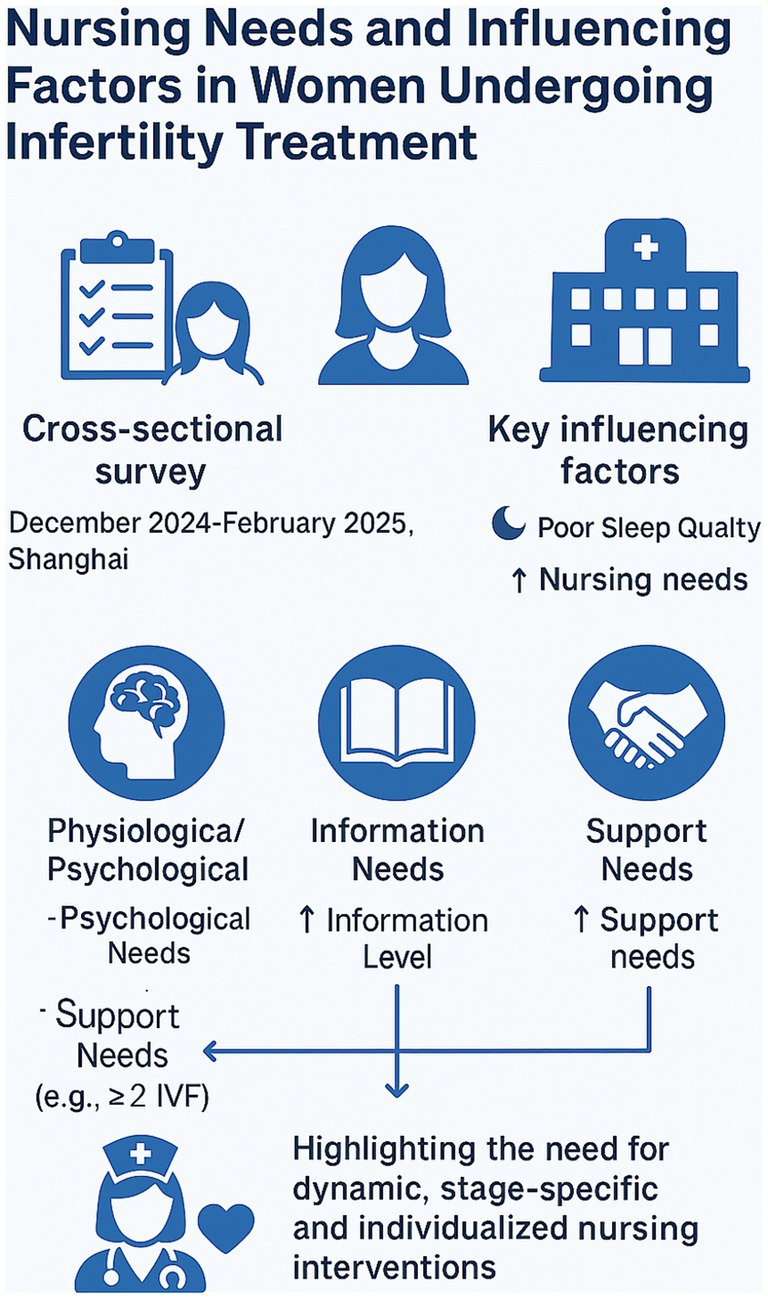
Figure 5. Graphical summary illustrating the nursing care needs of infertile women undergoing ART and the key influencing factors. A cross-sectional survey identified multidimensional nursing demands across psychological, informational, and support domains, with sleep quality, education level, and treatment stage as major predictors. The findings emphasize the necessity of dynamic, personalized nursing interventions.
Data availability statement
The original contributions presented in the study are included in the article/supplementary material, further inquiries can be directed to the corresponding authors.
Ethics statement
This study was reviewed and approved by the Medical Ethics Committee of Shanghai Changzheng Hospital. The ethical approval is valid from November 1, 2024 to February 28, 2025, and covers all relevant procedures, including participant recruitment, data collection, and analysis. The study does not involve animal experiments, clinical trials, or use of human tissues, but includes human participants and data. All participants received a full explanation of the study’s purpose, procedures, and confidentiality safeguards, and provided written informed consent before participation. This study was conducted in accordance with the ethical principles of the Declaration of Helsinki (2013 revision). The studies were conducted in accordance with the local legislation and institutional requirements. The participants provided their written informed consent to participate in this study.
Author contributions
XH: Writing – review & editing, Formal analysis, Methodology, Writing – original draft, Data curation. JLi: Conceptualization, Writing – review & editing, Data curation, Writing – original draft, Software, Resources. JLiu: Methodology, Validation, Data curation, Writing – review & editing, Writing – original draft, Formal analysis. NS: Validation, Writing – original draft, Resources, Writing – review & editing, Investigation. JS: Software, Visualization, Conceptualization, Writing – original draft, Writing – review & editing, Formal analysis. XZ: Software, Writing – original draft, Funding acquisition, Project administration, Methodology, Validation, Writing – review & editing. LL: Project administration, Writing – review & editing, Methodology, Writing – original draft, Supervision, Funding acquisition.
Funding
The author(s) declare that financial support was received for the research and/or publication of this article. This work was supported by the Summit Talent Program of Naval Medical University (grant no. 2022KYD11) and the Scientific Research Project of the Shanghai Municipal Health Commission (grant no. 20234Y0059).
Conflict of interest
The authors declare that the research was conducted in the absence of any commercial or financial relationships that could be construed as a potential conflict of interest.
Generative AI statement
The authors declare that no Gen AI was used in the creation of this manuscript.
Any alternative text (alt text) provided alongside figures in this article has been generated by Frontiers with the support of artificial intelligence and reasonable efforts have been made to ensure accuracy, including review by the authors wherever possible. If you identify any issues, please contact us.
Publisher’s note
All claims expressed in this article are solely those of the authors and do not necessarily represent those of their affiliated organizations, or those of the publisher, the editors and the reviewers. Any product that may be evaluated in this article, or claim that may be made by its manufacturer, is not guaranteed or endorsed by the publisher.
References
1. Liu, J, Zhu, F, Wang, Y, and Wu, J. Association between female cardiometabolic index and infertility: a population-based study. Front Public Health. (2025) 13:1513358. doi: 10.3389/fpubh.2025.1513358
2. Liang, Y, Huang, J, Zhao, Q, Mo, H, Su, Z, Feng, S, et al. Global, regional, and national prevalence and trends of infertility among individuals of reproductive age (15-49 years) from 1990 to 2021, with projections to 2040. Hum Reprod. (2025) 40:529–44. doi: 10.1093/humrep/deae292
3. Ardekani, OS, Letafati, A, Dehkordi, SE, Farahani, AV, Bahari, M, Mahdavi, B, et al. From infection to infertility: a review of the role of human papillomavirus-induced oxidative stress on reproductive health and infertility. Eur J Med Res. (2025) 30:339. doi: 10.1186/s40001-025-02605-4
4. Thapa, J, Adhikari, SP, Sedhain, N, and Shrestha, S. Clinical pattern of infertility among couple in reproductive age group attending in a tertiary care Centre. Kathmandu Univ Med J. (2025) 22:35–9.
5. Huerga López, C, Sánchez Martín, MJ, Herráez Moreta, A, Calvo Urrutia, M, Cristóbal García, I, Díaz Morillo, C, et al. Ligilactobacillus salivarius CECT5713 increases term pregnancies in women with infertility of unknown origin: a randomized, triple-blind, placebo-controlled trial. Nutrients. (2025) 17:1860. doi: 10.3390/nu17111860
6. Yokota, R, Okuhara, T, Okada, H, Furukawa, E, Shirabe, R, Agawa, T, et al. Development and psychometric evaluation of the infertility public stigma scale for Japanese women: protocol for an exploratory sequential mixed method study of the Japanese population. Front Public Health. (2025) 13:1504842. doi: 10.3389/fpubh.2025.1504842
7. Li, X, Wei, M, Zou, J, Wei, J, Lai, X, Gong, X, et al. Infertility trends in China: analyzing temporal changes, public demand, and demographic differences based on Baidu index. BMC Public Health. (2025) 25:2481. doi: 10.1186/s12889-025-23655-7
8. Park, J, Shin, N, and Lee, K. Development and validation of a tool to assess nursing needs of infertile women. Korean J Women Health Nurs. (2020) 26:141–50. doi: 10.4069/kjwhn.2020.03.31.1
9. Yang, XP, Chen, J, and Sun, MY. Investigation on the nursing knowledge needs of infertile patients and their spouses outside hospital. Shanghai Nurs J. (2018) 18:10–2. doi: 10.3969/j.issn.1009-8399.2018.03.003
10. Liu, K, Dou, S, Qin, W, Zhao, D, Zheng, W, Wang, D, et al. Association between quality of life and resilience in infertile patients: a systematic review. Front Public Health. (2024) 12:1345899. doi: 10.3389/fpubh.2024.1345899
11. Zhang, Y, Jiang, WB, Lin, H, Lu, LX, Li, YM, GU, RT, et al. Survey on fertility intention of third-child among clinical nurses of childbearing age. Mat Child Health Care China. (2023) 38:1092–6. doi: 10.19829/j.zgfybj.issn.1001-4411.2023.06.031
12. Li, BX, Chen, F, and Wang, JP. Sinicization and reliability and validity test of the nursing needs assessment scale for infertile patients. Chin J Family Plan Obstetr Gynecol. (2024) 16:85–8. doi: 10.3969/j.issn.1674-4020.2024.09.22
13. Naab, F, van der Wath, AE, Kyei, JM, and Armah, D. “Spirituality as a coping strategy for infertility”: a scoping review. J Relig Health. (2025) 64:2813–31. doi: 10.1007/s10943-025-02302-w
14. Chen, J, and Bo, HX. Qualitative study on sexual life experience of infertile patients. Chin J Pract Nurs. (2017) 33:2518–22. doi: 10.3760/cma.j.issn.1672-7088.2017.32.010
15. Salari, N, Babajani, F, Hosseinian-Far, A, Hasheminezhad, R, Abdoli, N, Haydarisharaf, P, et al. Global prevalence of major depressive disorder, generalized anxiety, stress, and depression among infertile women: a systematic review and meta-analysis. Arch Gynecol Obstet. (2024) 309:1833–46. doi: 10.1007/s00404-024-07444-y
16. Lewis, AM, Liu, D, Stuart, SP, and Ryan, G. Less depressed or less forthcoming? Self-report of depression symptoms in women preparing for in vitro fertilization. Arch Womens Ment Health. (2013) 16:87–92. doi: 10.1007/s00737-012-0317-8
17. Wen, H, and Gong, F. Investigation on psychological status of women with primary infertility undergoing in vitro fertilization-embryo transfer. PLA J Nurs. (2017) 34:30–3. doi: 10.3969/j.issn.1008-9993.2017.03.007
18. Chen, J, Bo, HX, and Duan, YP. Study on reproductive quality of life and influencing factors in infertile female patients. J Nurs. (2018) 25:1–5. doi: 10.16460/j.issn1008-9969.2018.13.001
19. Lin, YH, Chueh, KH, and Lin, JL. Somatic symptoms, sleep disturbance and psychological distress among women undergoing oocyte pick-up and in vitro fertilisation-embryo transfer. J Clin Nurs. (2016) 25:1748–56. doi: 10.1111/jocn.13194
20. Gençtürk, N, Yıldız Karaahmet, A, Shafaati Laleh, S, and Guksu, Z. The relationship between infertility and sleep quality in women: systematic review and meta-analysis. Actas Urologicas Espanolas. (2024) 48:185–203. doi: 10.1016/j.acuroe.2023.12.002
21. Kirca, N, and Özcan, Ş. The effects of nursing care based on Levine's conservation model on fatigue, depression, perceived social support, and sleep quality in infertile women: a randomized controlled trial. Int J Nurs Knowl. (2023) 34:284–96. doi: 10.1111/2047-3095.12402
22. Early, ML, Kumar, P, Marcell, AV, Lawson, C, Christianson, M, and Pecker, LH. Literacy assessment of preimplantation genetic patient education materials exceed national reading levels. J Assist Reprod Genet. (2020) 37:1913–22. doi: 10.1007/s10815-020-01837-z
23. Shreffler, KM, Greil, AL, and McQuillan, J. Responding to infertility: lessons from a growing body of research and suggested guidelines for practice. Fam Relat. (2017) 66:644–58. doi: 10.1111/fare.12281
24. Swift, BE, and Liu, KE. The effect of age, ethnicity, and level of education on fertility awareness and duration of infertility. J Obstet Gynaecol Can. (2014) 36:990–6. doi: 10.1016/S1701-2163(15)30412-6
25. Patel, S, and Dowse, R. Understanding the medicines information-seeking behaviour and information needs of south African long-term patients with limited literacy skills. Health Expect. (2015) 18:1494–507. doi: 10.1111/hex.12131
26. Dunn, P, and Conard, S. Improving health literacy in patients with chronic conditions: a call to action. Int J Cardiol. (2018) 273:249–51. doi: 10.1016/j.ijcard.2018.08.090
27. Soysal, C, and Ozmen, U. Intrauterine insemination in ovulatory infertile patients. Niger J Clin Pract. (2018) 21:1374–9. doi: 10.4103/njcp.njcp_64_17
28. Osmanlıoğlu, Ş, Şükür, YE, Tokgöz, VY, Özmen, B, Sönmezer, M, Berker, B, et al. Intrauterine insemination with ovarian stimulation is a successful step prior to assisted reproductive technology for couples with unexplained infertility. J Obstet Gynaecol. (2022) 42:472–7. doi: 10.1080/01443615.2021.1916805
29. Wang, BJ, Sun, H, and Sun, HX. Qualitative study on health information needs of patients undergoing IVF-ET. Chin J Reprod Contracept. (2017) 37:750–3. doi: 10.3760/cma.j.issn.2096-2916.2017.09.012
30. Holton, S, Hammarberg, K, and Johnson, L. Fertility concerns and related information needs and preferences of women with PCOS. Human Reproduct Open. (2018) 2018:hoy019. doi: 10.1093/hropen/hoy019
31. Shi, X, Hong, YZ, Wang, DP, and Peng, YH. Effect analysis of staged health education model in the nursing of patients undergoing assisted reproductive technology. Int J Nurs. (2018) 37:3096–9. doi: 10.3760/cma.j.issn.1673-4351.2018.22.024
Keywords: infertility, nursing needs, assisted reproductive technology, sleep quality, multiple linear regression
Citation: Hu X, Li J, Liu J, Sun N, Shi J, Zhai X and Li L (2025) Exploring nursing care needs and the role of sleep quality in women undergoing infertility treatment: implications for personalized nursing interventions. Front. Public Health. 13:1674046. doi: 10.3389/fpubh.2025.1674046
Edited by:
A. S. Ansari, University of Rajasthan, IndiaReviewed by:
Limor Dina Gonen, Ariel University, IsraelLeila Mahasti Jouybari, Golestan University of Medical Sciences, Iran
Copyright © 2025 Hu, Li, Liu, Sun, Shi, Zhai and Li. This is an open-access article distributed under the terms of the Creative Commons Attribution License (CC BY). The use, distribution or reproduction in other forums is permitted, provided the original author(s) and the copyright owner(s) are credited and that the original publication in this journal is cited, in accordance with accepted academic practice. No use, distribution or reproduction is permitted which does not comply with these terms.
*Correspondence: Lingling Li, MTM5MTY5NjYxOTFAMTYzLmNvbQ==; Xiaohui Zhai, MTg5MTgyNjAwMjdAMTYzLmNvbQ==
†These authors have contributed equally to this work
 Xiaoyuan Hu1†
Xiaoyuan Hu1† Ningxia Sun
Ningxia Sun Lingling Li
Lingling Li